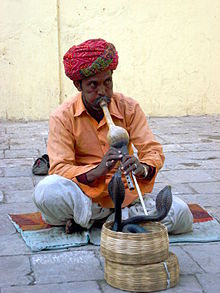
Back ترويض الأفاعي Arabic সাপুড়ে Bengali/Bangla Encantament de serps Catalan Schlangenbeschwörer German Serpentodresisto Esperanto Encantamiento de serpientes Spanish Käärmeenlumooja Finnish Charmeur de serpents French היפנוט נחשים HE सपेरा Hindi
This article has multiple issues. Please help improve it or discuss these issues on the talk page. (Learn how and when to remove these template messages)
|

Snake charming is the practice of appearing to hypnotize a snake (often a cobra) by playing and waving around an instrument called a pungi. A typical performance may also include handling the snakes or performing other seemingly dangerous acts, as well as other street performance staples, like juggling and sleight of hand. The practice was historically the profession of some tribesmen in India well into the 20th century but snake charming declined rapidly after the government banned the practice in 1972.[1][2] Snake-charmer performances still happen in other Asian nations such as Pakistan,[3] Bangladesh, Sri Lanka, Thailand and Malaysia. The tradition is also practiced in North African countries of Egypt, Morocco, and Tunisia.
Ancient Egypt was home to one form of snake charming, though the practice as it exists today likely arose in India.[citation needed] It eventually spread throughout South Asia, Southeast Asia, the Middle East, and North Africa. Despite a sort of golden age in the 20th century, snake charming is today dying out. This is due to a variety of factors, chief among them is the enforcement of the Wildlife Protection Act, 1972 in India banning ownership of snakes. In retaliation, snake charmers have organized in recent years, protesting the loss of their only means of livelihood, and the government has made some overtures to them. Snake charming is almost extinct in India.[1][4]
Many snake charmers live a wandering existence, visiting towns and villages on market days and during festivals. During a performance, snake charmers may take a number of precautions. The charmer typically sits out of biting range[5]: 251 and the snake is usually sluggish due to starvation or dehydration and reluctant to attack anyway. More drastic means of protection include removing the reptile's fangs or venom glands, drugging the snake,[5]: 251 or even sewing the snake's mouth shut. [6] The most popular species are those native to the snake charmer's home region, typically various kinds of cobras, though vipers and other types are also used.
Although snakes are able to sense sound, they lack the outer ear that would enable them to hear the music. They follow the movement of the charmer and the pungi that the charmer holds with his hands.[5]: 251 The snake considers the person and pungi a threat and responds to it as if it were a predator.
- ^ a b Chandra, Sharmila (12 November 2013). "India's snake-charmers sway on the edge of extinction A traditional art form faces extinction". India Today. Retrieved 16 April 2020.
- ^ Harding, Luke (2 April 2002). "Snake tricks lose their charm". The Guardian. Retrieved 16 April 2020.
- ^ Amtul Jamil (21–27 December 2012), "Snakes and charmers", The Friday Times, vol. XXIV, no. 45. Umerkot is one of the centers of the craft in Pakistan.
- ^ Harding, Luke (2 April 2002). "Snakes tricks lose their charm". The Guardian. Retrieved 16 April 2020.
- ^ a b c Nickell, Joe (2005). Secrets of the sideshows. Lexington, Ky.: University Press of Kentucky. ISBN 0-8131-7179-2. OCLC 65377460.
- ^ Highfield, Andy C. and Bayley, Jane R. "Folklore, Myth, and Exploitation of snakes in Morocco and Tunisia". Tortoisetrust.org. Section "Snakes".
© MMXXIII Rich X Search. We shall prevail. All rights reserved. Rich X Search